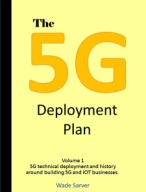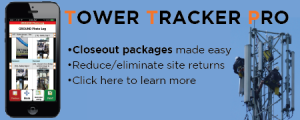Podcast: Play in new window | Download | Embed
Subscribe: Apple Podcasts | RSS
The Smart City 5G Business Plan
- Build your business case around your needs. Think of who will use it. Most cities think that they can put everyone on one system, but that’s not practical.
- The thing about a smart city is that there is more to it than wireless. Smart cities are about communication, efficiently and everywhere, but also about the energy savings and the lighting and the efficiency that will save money.

- The residents want a well-connected A city wants to run as cost effectively as possible and safety.
- The government wants a city with low costs for power and communications and a safe city.
- Tourists want a well-connected, (Wi-Fi and carrier coverage), and safe city. They also want to get around easy and find places to go, so apps that help them do that will give the city a good reputation and spreads a lot of good will.
- A smart city to be run smart, costs should be kept to a minimum for not only communications but for electrical and safety. It all adds up. If you are billing each department, from
 electric to water to gas to garbage, then think of each source of revenue. Think of the tourism and the residents because they will be paying the bills.
electric to water to gas to garbage, then think of each source of revenue. Think of the tourism and the residents because they will be paying the bills. - What about the buildings? Most smart cities don’t care about the buildings unless they are city buildings. Then they want to save costs. If you can make the buildings, say museums, part of the smart city rollout, it would help shine the light on what the features are of the city as well as provide cost savings for operations. Cities may do this because it could use grant money, a key to rolling out smart cities would be a great way to use it.
- Don’t forget the parking meters, open spaces for parking, traffic management, red light management, and remote management of almost all city assets. Even smart meters for gas or electric or water play into this.
- The thing about a smart city is that there is more to it than wireless. Smart cities are about communication, efficiently and everywhere, but also about the energy savings and the lighting and the efficiency that will save money.
Sign-up to get all your updates!
Don’t miss an episode on iTunes or Stitcher or Overcast
- Coverage would be the city or area that they want to cover. I should be honest; most cities would never spend much money on a public wireless network. In fact, they would put it in, but they would not want to spend the money to maintain something like that. There are exceptions, like New York City where they put Wi-Fi hotspots around the city for the tourists and locals. That is where the public/private partnership comes into play. I’ll discuss more on that below. The coverage for a city may seem obvious, but I’ve built networks where the cities cover not only city limits but the outskirts of town and other places nearby to work
 partnerships with neighboring communities and municipalities. Don’t just think about city limits, think about partners. In this case, though you may want to read meters, turn lamps on and off, control vehicles throughout the city, monitor traffic lights or even sewer levels.
partnerships with neighboring communities and municipalities. Don’t just think about city limits, think about partners. In this case, though you may want to read meters, turn lamps on and off, control vehicles throughout the city, monitor traffic lights or even sewer levels. - The goal of this coverage needs to be thought deeply about because you need to know what the use case is. Is it for video and security? Is it for the residents to have internet access? Is it for police and fire workers to have internet access? Is it for the workers to have network access? If you are building it for the city, think about how to maintain it as well as coverage. The functionality may be for meters today, or lampposts, but what do you want to add to the system? What could be a potential target for a year?
The Wireless Deployment Handbook Paperback and
 The Wireless Deployment Handbook eBook that covers professional carrier end to end deployment of LTE small cells, CRAN, and DAS showing you the proper way to plan for deployment then execute.
The Wireless Deployment Handbook eBook that covers professional carrier end to end deployment of LTE small cells, CRAN, and DAS showing you the proper way to plan for deployment then execute.
- The budget will be determined by what you use it for. The key to smart cities is to provide services and to save costs.
- The coverage will determine the budget. The coverage will not be solid in most cases. Make sure you figure it out what the needs are for the use. The thing is when the smart city planners start looking at the budget they will look beyond the wireless CapEx and into the OpEx. They will take the maintenance and monthly costs of the service into account. They will also look at what the electric bills will be. Who will be looking at the data? You could manage the system in a central location, or the system may need to send the data to different NOCs throughout the city. If you plan to cover multiple types of equipment, like from water levels to gas pressure levels to traffic lights, then you need to make sure each group can grab
 some of your data. Several cities are even thinking of garbage levels in waste bins so they can pick it up before it runs over. These are all target goals for coverage and send out data.
some of your data. Several cities are even thinking of garbage levels in waste bins so they can pick it up before it runs over. These are all target goals for coverage and send out data. - Is it a prevailing wage area? Is it union required area? If you think it doesn’t matter, let me tell you a story. I was working in Philly, coverage testing. To do this my partner and I had a bucket truck to test. The rules are the engineer could use a radio and a laptop but no tools. So, before we went into Philly, we put all the tools in the truck box and locked them up. We were down an ally, on a back street, behind some abandoned buildings. Sure enough, a black Lincoln pulls up, and the guy jumps out and starts yelling at us to see our union cards. My partner was ready for this and explained that we’re engineers, not workers. He had the paperwork and our business cards. This guy didn’t care; he started to call everyone, including the city. He got all the answers that we gave him, but that wasn’t good enough, he called the union halls to make sure there was not work being done on that street. Then he watched us for the next 3 hours or so from his car. We went from street to street to test, and he followed us most of the day, making sure we didn’t touch any tools.
- Are you providing outdoor coverage only or venues or streets? What about smart buildings? Traffic lights? What apps are you adding? What will be the use, video? Will you control the traffic lights or just monitor the traffic or do both? Will you turn the street lamps on and off? Are you adding free Wi-Fi for tourists and residents?
- The coverage will determine the budget. The coverage will not be solid in most cases. Make sure you figure it out what the needs are for the use. The thing is when the smart city planners start looking at the budget they will look beyond the wireless CapEx and into the OpEx. They will take the maintenance and monthly costs of the service into account. They will also look at what the electric bills will be. Who will be looking at the data? You could manage the system in a central location, or the system may need to send the data to different NOCs throughout the city. If you plan to cover multiple types of equipment, like from water levels to gas pressure levels to traffic lights, then you need to make sure each group can grab
- Spectrum for smart cities can vary based on what the goal is.
- You may want to be sure that your emergency responders have high-speed internet throughout the city, the thing you need to look at is whether it’s dedicated to them or if they will share a public network. What data will they be passing and what encryption will they be passing. If it is for data only, then it may not be mission critical. The only time it may be an issue of there is an emergency in an area where there are a lot of spectators and reports that are sharing the public Wi-Fi. The same happens to cell sites during an emergency; they get overloaded causing them to go down or drop calls.
- Internet access for the citizens and tourist is one of the most obvious uses of Wi-Fi. Maybe LTE-U will start to ramp up but the way I see it, this is a great service. No one looks at Wi-Fi to have great coverage, but rather hotspots. So, this is something that you could strategically place on city-owned poles or kiosks. Always a good idea to make the residents and tourists happy.
- Monitor and control traffic lights could take a licensed spectrum, low latency. It should be an IOT play, maybe in the 900MHz spectrum. Make sure you have the timers in there for backup.
- Video will need high spectrum, like mmwave. Many cities have used Wi-Fi on a dedicated network. It worked well in the past when properly engineered. I would not just throw up a network, plan, and engineer.
- Parking meters and garage space monitoring would be a great IOT play with low-bandwidth. However, chances are you may have Wi-Fi in those areas, or maybe, in a parking garage you could have a video application. You may piggyback on of another system. It should all go back to a NOC to monitor. The deal with parking meters is that they may take a credit card which would need to be approved quickly or a remote need approval. Think through the application and latency before just jumping into an existing system.
- If you are going to capture data to do analytics, then think of IOT. What are you going to monitor and control? Traffic lights? Video cameras? All of this is something that you may want to add to your smart city network. There’s a variety of spectrum options. Just like reading meters, like parking meters and monitoring the parking garages. The video would add safety for the city and a way to track criminals pursued throughout the city.
Be smart, be safe, and pay attention!
The foundations below do beautiful work, helping families in their time of need. Climbers often get seriously injured or die on the job. The foundations below support those families in their time of greatest need!
Hubble Foundation helps the families of climbers in time of need!
Tower Family Foundation supports the families r tower climbers at the time of crisis when a climber falls.




